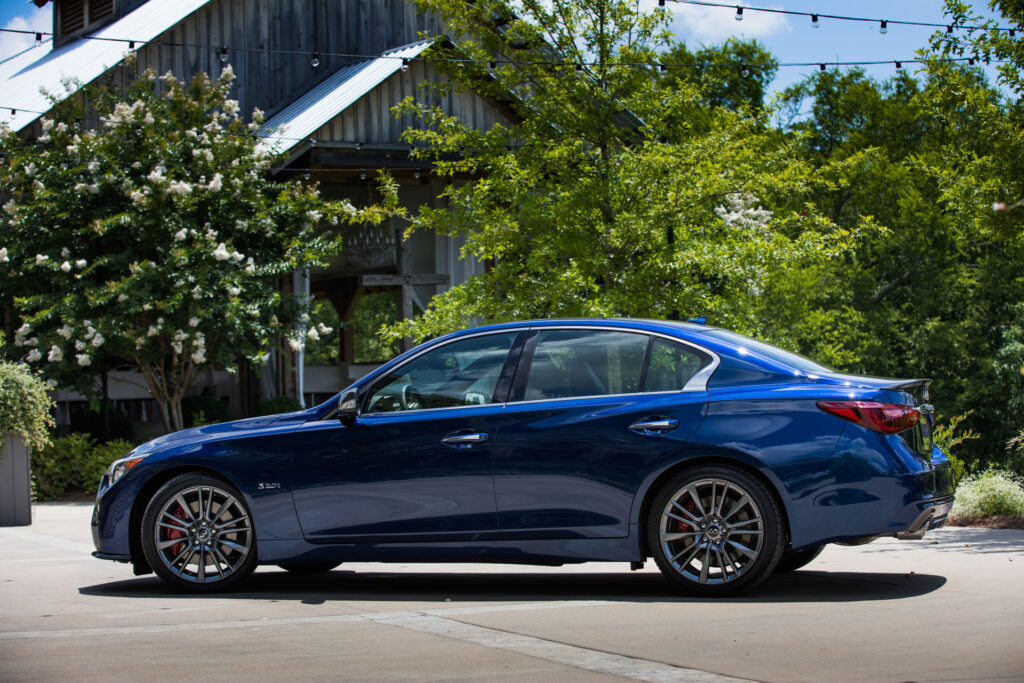
An impressive roster of standard equipment pairs with Infiniti’s traditionally deep array of packaged extras. That’s enough to earn the Q50 a 7 out of 10 on our features scale. (Read more about how we rate cars.)
Base Q50s come impressively equipped with standard LED headlights—high and low-beams—and taillights, eight-way adjustable seats, the full InTouch infotainment system with an 8.0-inch upper screen and a 7.0-inch lower screen, Bluetooth connectivity, dual-zone climate control, and a six-speaker audio system with HD and satellite radio for $35,105 (including a mandatory $905 destination charge).
For the extra goodies, you need the Q50 Luxe. Four-cylinder examples start at $37,455 for rear-wheel drive and $39,455 for all-wheel drive, while the V-6 variant costs $39,855 with rear-drive—add $2,000 for all-wheel drive. The Luxe trim doesn’t add much equipment on its own—there’s a standard sunroof, and maple wood trim replaces Lunar Black plastic—but it does grant owners access to a pair of impressive option packages. The Luxe trim also serves as the basis for the Q50 Hybrid, which starts at $51,505.
For those with sportier needs, Q50 Sport starts at $41,555. Aside from the more aggressive visuals and performance features, like 19-inch wheels on more aggressive rubber, the Sport trim gets standard leather upholstery with adjustable lumbar, bolstering, and thigh extensions, and aluminum interior trim.
Finally, the Red Sport 400 includes a 400-hp version of the 3.0-liter, twin-turbocharged V-6, standard navigation, paddle shifters, rear parking sensors, a surround-view camera system, heated front seats, and a heated steering wheel. Prices start at $51,905.
Each of these trim levels is available with a $2,000 all-wheel-drive system, while Infiniti also offers a rather messy collection of option packages, many of which are dependent on each other.
The Essential Package is aptly named—for $2,450 on the 2.0-liter Luxe, $2,600 on the 3.0-liter Luxe, and $2,500 on the Sport, it adds navigation, a heated steering wheel and front seats, and a split-folding rear seat across the board. The Essentials Package also adds leather upholstery to the V-6-powered Luxe, a feature that’s standard on the Sport (which explains the price differences).
The ProAssist Package is available on 4- and 6-cylinder Luxe models and the Q50 Sport for $1,650. It requires the Essential Package on the Luxe and the Performance Package on the Sport and adds blind-spot monitoring with rear cross-traffic alert, a surround-view camera system, and forward collision warning with automatic emergency braking.
Speaking of the Performance Package, it’s a $1,500 option and requires the Essential Package on the Sport, while it’s standard on the Red Sport 400. This pack adds an adaptive suspension, larger brakes, and steering-wheel-mounted paddle shifters.
The Sensory Package comes in both Luxe and Sport varieties, but is a V-6-only item (including the Red Sport 400). The small price difference between these two, $2,950 for the former and $2,650 for the latter, reflects the leather upholstery the package adds to the Luxe—leather is already standard on the Sport. Beyond that difference, this package adds a 16-speaker Bose stereo, a power tilt and telescopic steering wheel, auto-dimming exterior mirrors, a memory function for the driver’s seat, and an upgraded climate control system. The ProAssist Package (and illuminated kickplates, for some reason) are a prerequisite for the Sensory Package, except on the Red Sport 400, which includes ProAssist as standard.
The $2,700 ProActive Package is available on the V-6-powered Luxe, Sport, and Red Sport 400 and adds lane departure warning and prevention, adaptive cruise control, adaptive front lighting, distance control assist, and Direct Adaptive Steering (for better or worse). It requires the Sensory Package and a $400 “radiant grille emblem.”



